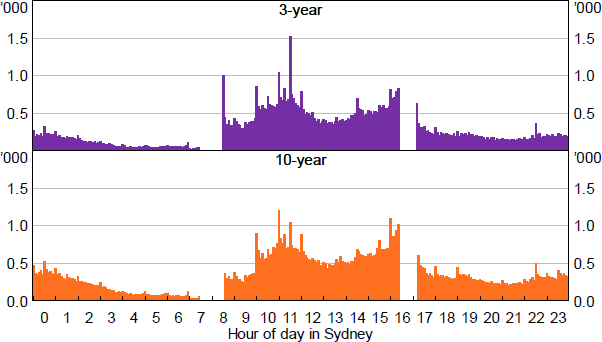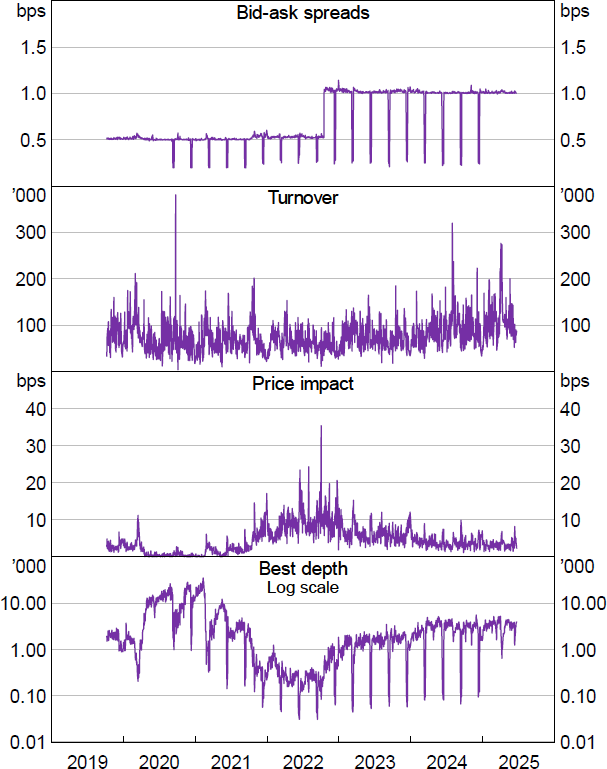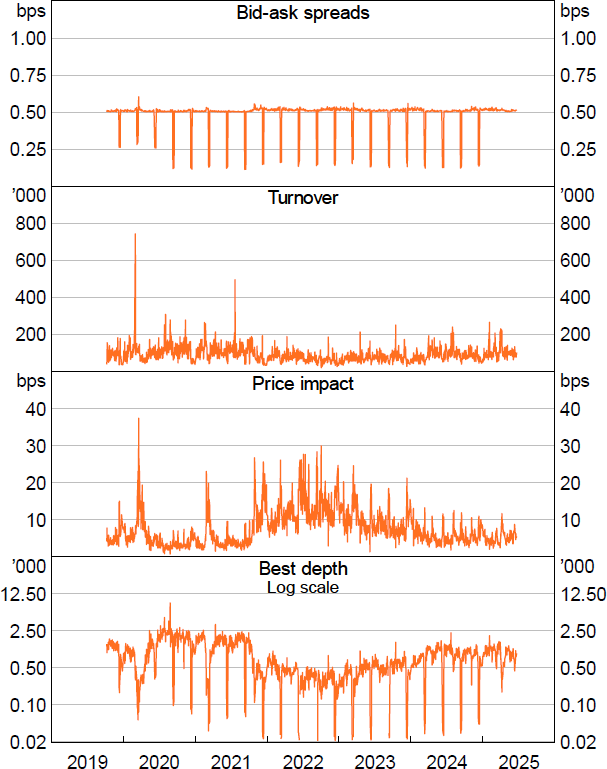RDP 2025-07: Back to the Futures: Liquidity in Australian Bond Futures amid Market-moving Events since COVID-19 3. Data and Some Descriptive Statistics
October 2025
We use tick-level data on 3-year and 10-year AGS futures contracts, including trades, and bids or asks at the top of the order book (i.e. at the current best price). Each data point includes price, volume, date-time information, and other metadata. The tick-level data are updated any time a trade is executed or the volume or price at the best bid or ask changes. Volume and/or price changes for bids and asks are much more common than trades, at around 90 per cent of data points, with trades making up the remaining 10 per cent. Our dataset runs from October 2019 to June 2025.
AGS futures trade almost 24 hours a day. Very early in the Sydney morning is the least liquid time of the day, while activity picks up from 08.30 as the Sydney trading day begins, and increases further mid-morning as Asian markets open. There is a notable drop in liquidity around the Sydney lunchtime, before activity picks up again over the afternoon, with the opening of European markets towards the end of the Sydney trading day providing a further boost. We focus on the Australian day session (08.30 to 16.30) as this is the most liquid time period and also the period in which major Australian events such as data releases, monetary policy decisions, and central bank bond purchases occur (Figure 2).

Notes: Turnover excludes trades associated with futures roll activity, and turnover is not shown for: the open auctions of both the day and night sessions; and the close of the day session. For 3-year futures, this means that the 5-minute intervals starting 08:20, 08:25, 16:25, 17:00 and 17:05 are not shown. For 10-year futures, in addition to these intervals, the 5-minute intervals starting 08:30 and 17:10 are also not shown, because the day and night sessions start 2 minutes later for 10-year futures.
Sources: Authors’ calculations; Bloomberg.
We remove trades associated with futures roll activity, since such trades inflate turnover volumes without being associated with liquidity or affecting the price.[4] We also remove cross trades (that is, trades where the buyer and seller are one and the same) and trades with prices and sizes of zero. This leaves us with 29 million data points for the 3-year contract and 68 million data points for the 10-year contract.
To conduct the main analysis, we transform the tick-level data into 5-minute buckets, with the main variables of interest being:[5]
- Last price, defined as the midpoint of the last bid and ask recorded in the 5-minute bucket.
- Change in price, defined as the last price of the given bucket, minus the last price from the previous bucket.
- Bid-ask spread, defined as the average bid-ask spread across all observations that occur within the 5-minute bucket.
- Best depth, defined as the average volume available to trade at the top of the order book across all observations that occur within the bucket; we calculate bid depth (i.e. average volume available to trade at the best bid) and ask depth (i.e. average volume available to trade at the best ask), and best depth is the average of bid depth and ask depth. Similar to Adrian, Fleming and Vogt (2017), we find that the natural logarithm of depth has a more stable relationship with the other variables of interest than the level of depth, so we use the log of depth in the analysis that follows.
- Turnover, defined as the sum of trading volume occurring within the bucket; we calculate seller-initiated turnover (i.e. trades that occur at the bid price), buyer-initiated turnover (i.e. trades that occur at the ask price), and total turnover (i.e. the sum of any trades that occur).
-
Price impact, which we define as the impact on price from buying 10,000 contracts (equivalent to $1 billion face value of bonds). Price impact must be estimated, rather than simply calculated from the data as for the previous indicators. We do this by regressing the change in price, in basis points, on net buyer-initiated trades (i.e. buyer-initiated turnover less seller-initiated turnover). These regressions are estimated over a trailing 90-minute window using tick-level data aggregated into 30-second buckets, for a total of 180 observations per regression window.
Our estimate of price impact will be valid to the extent that prices only move due to order flow (which in turn may evolve due to various factors). While this will often be a reasonable assumption, it is unlikely to hold while the market is absorbing the implications of material new information, when prices can shift independent of actual trades. If any independent change in price is associated with a concurrent change in order flow, the price impact regression will suffer from endogeneity issues and be biased. To reduce the likelihood of this occurring, we exclude data 5 minutes either side of 11:30 and 14:30 from our price impact regressions; this gives a window for prices to adjust to key news events – specifically, ABS data releases and RBA policy announcements – without affecting estimated price impact. See, for example, Kyle (1985), Fleming (2003, 2024), Bouchaud (2010) or Adrian et al (2017) for further discussion of price impact and its estimation.
The median estimated price impact across the 3- and 10-year futures contracts is 3 and 6 basis points, respectively. That is, 10,000 net buyer-initiated trades, equivalent to a bond purchase of $1 billion face value, are associated with an increase in futures price, or decrease in the futures-implied yield, of 3 or 6 basis points. Low price impact – where large trades in either direction have only a modest impact on price – is indicative of a liquid market.
The final four metrics – bid-ask spread, depth, turnover, and price impact – are commonly used as measures of liquidity. In general, one might expect higher liquidity to be indicated with higher depth, higher turnover, lower bid-ask spreads, and lower price impact.
Price impact is conceptually appealing as it is close to what most market participants mean when they discuss liquidity: the ability to trade in large size without adversely moving the price. Conversely, it must be estimated, and the estimate may be biased in some circumstances, whereas the other measures can simply be calculated from the data. Depth is also a measure of the ability to trade in size without moving the market, since one can always transact the volume shown at the top of the order book at the current best bid/ask. Bid-ask spreads on the other hand measure transaction costs, rather than the ability to trade in size, while turnover measures the volume of trading but is agnostic on transaction costs or whether that trading moves prices.
In practice, depth and price impact seem to respond similarly to the events studied, which we take as supporting the case for both as good measures of liquidity. On the other hand, our findings suggest that bid-ask spreads and turnover are less informative as measures of liquidity for the AGS futures market. For bid-ask spreads, this is because they can be unresponsive to periods of poor liquidity as long as the minimum price increment remains binding. For turnover, this is because the response to periods of poor liquidity can be ambiguous (conceptually, turnover is more of a measure of disagreement than liquidity).
Figures 3 and 4 display our four liquidity metrics from October 2019 to June 2025, aggregated to the daily total for turnover and daily averages for other measures, for the 3-year and 10-year futures contracts respectively. A few points immediately stand out:
- The quarterly futures roll period – that is, the week leading up to the expiry of the current futures contract – is a major event in the futures market, with bid-ask spreads consistently falling to close to the new minimum price increment when this is in effect, best market depth falling significantly, and to a lesser extent price impact increasing.[6] The roll period is explored further in Section 5.
- For the 3-year contract, there is a step up in bid-ask spreads in October 2022, when the ASX increased the minimum price increment for the contract outside of roll periods, with price impact and best depth seeming to improve from around when the change was implemented. The effects of this change on liquidity are also explored further in Section 5.
- Outside of roll periods, March 2020 stands out as a period of reduced liquidity, with bid-ask spreads and price impact higher, and depth lower. This period is explored further in Section 4.
- From late 2021 and through 2022, depth is consistently low, price impact is consistently elevated, and bid-ask spreads are higher than usual. This likely reflects, in the first instance, some disruption to the market caused by the removal of the yield target, and more broadly an increase in uncertainty and volatility associated with a period of rising inflation and interest rates. This period is also explored further in Section 4.
- Conversely, apart from spiking higher during certain stress events such as around March 2020, turnover exhibits no clear pattern through time.

Notes: Best depth and turnover are shown in thousands of contracts. Price impact is shown in basis points per $1 billion of net flow.
Sources: Authors’ calculations; Bloomberg.

Notes: Best depth and turnover are shown in thousands of contracts. Price impact is shown in basis points per $1 billion of net flow.
Sources: Authors’ calculations; Bloomberg.
The autocorrelation function of each liquidity metric on a daily basis is shown in Figure 5. We see that market depth is the most persistent variable, implying that it can take considerable time for depth to recover following a shock. Price impact is also relatively persistent, while bid-ask spreads and turnover are generally less persistent. These results accord with Meldrum and Sokolinskiy (2025; see, for example, their Figure 2) and Aronovich, Dobrev and Meldrum (2021), and also align with traders’ perceptions, which are that depth often takes considerable time to recover following a shock, whereas bid-ask spreads and turnover return toward normal levels much more quickly.[7]

Note: For 3-year futures, the sample for autocorrelations of bid-ask spreads is split into those prior to the widening of spreads with the increase in the minimum increment for 3-year futures on 18 October 2022 (‘pre-widen’) and those after it (‘post-widen’).
Sources: Authors’ calculations; Bloomberg.
As discussed in Section 2, the literature typically finds that periods of market volatility are associated with higher turnover but a deterioration in other measures of liquidity, and we find similar results. Returning to 5-minute data and taking the analysis a little further, we find that:[8]
- Bid-ask spreads are sensitive to price volatility, as one might expect, although the effect size is small. For the 3-year and 10-year contracts, average bid-ask spreads in a 5-minute window widen by around 0.02 and 0.01 basis points, respectively, for each 1 basis point change in price that occurs over the window, both significant at the 1 per cent level. For comparison, outside of roll periods and considering the period when the minimum price increment was 0.5 basis points, the median bid-ask spread for the 3-year contract is 0.51 basis points, and for the 10-year contract it is 0.50 basis points. That is, the bid-ask spread is typically equal to the minimum price increment allowed by the exchange, which is also 0.5 basis points over most of the sample.
- Order book depth is also sensitive to price volatility. For both the 3-year and 10-year contracts, best depth in a 5-minute window falls by around 10 per cent for each 1 basis point change in price, significant at the 1 per cent level.
- Conversely, turnover increases with price volatility. For the 3-year contract each 1 basis point change in price over a 5-minute window is associated with 1,200 more contracts trading, while for the 10-year contract each 1 basis point change in price is associated with 1,270 more contracts trading (median turnover in a 5-minute window is 280 and 420 for the 3-year and 10-year contracts respectively). Unsurprisingly, the direction of price change has an impact on whether trades tend to occur at the prevailing bid or ask price, with a 1 basis point increase in price associated with around 530 more trades executed at the prevailing ask price rather than bid price for the 3-year contract, and 590 more trades executed at the prevailing ask price rather than bid price for the 10-year contract. That is, when the price is going up, more trades occur at the top of the bid-ask spread, and when the price is going down more trades occur at the bottom of the bid-ask spread.
- Price impact is lower – that is, liquidity is higher – when top-of-book order depth is higher, again as one might expect.[9] For the 3-year contract, a doubling of depth in a 5-minute window is associated with the price impact of trading 10,000 contracts being 0.3 basis points lower, while for the 10-year contract the price impact is 1 basis point lower, both significant at the 1 per cent level. As noted above, the median price impact from trading 10,000 contracts is 3 and 6 basis points, respectively, for the 3-year and 10-year contract.
- While we do not focus on order imbalance in our analysis, we find – similar to some other studies – a small positive contemporaneous relationship between order imbalance and changes in price, and a negative relationship between past price changes and order imbalance. That is, greater order imbalance is associated with a higher price contemporaneously (although the size of the effect is small), while an increase in price is associated with a fall in the number of bids to purchase compared with the number of offers to sell.[10]
Footnotes
The futures roll occurs in the week leading up to a contract's expiry, when investors with a position in the expiring contract ‘roll’ their position into the next contract. They do this by closing out their position in the expiring contract and opening an equivalent position in the next contract. For example, if an investor has an existing position of 100 expiring contracts, they may transact to sell 100 expiring contracts (leaving their net position at zero) and purchase 100 of the next contracts (re-establishing their original position). There is a separate market for roll trades, in which offsetting trades in the expiring and next contract are agreed as a single package. The separate roll market was previously linked to the outright futures market, such that the minimum price increment was the same across the two, but they were delinked starting from the March 2025 futures roll. [4]
Except for the first bucket of the trading day, an observation is counted as within a bucket if it occurs after the beginning of the bucket, and at or before the end of the bucket. So, for example, the 09.00 to 09.05 bucket contains data from 09:00:01 to 09:05:00. The first bucket of the trading day also includes observations at the start of the bucket (i.e. it runs from 08:30:00 to 08:35:00). [5]
For the 3-year contract the minimum price increment, and therefore the minimum possible bid-ask spread, is 0.5 basis points outside of roll periods from the start of our sample until October 2022, and 1 basis point thereafter; during roll periods the minimum price increment is 0.5 basis points for the December 2019, March 2020, and June 2020 rolls, and 0.2 basis points from September 2020 until December 2024. From March 2025 the roll and outright market are delinked, so that the roll market trades in 0.2 basis point increments while the outright market trades in 1 basis point increments. For the 10-year contract the minimum price increment is 0.5 basis points outside of roll periods for the entire sample; during roll periods the minimum price increment is 0.25 basis points for the December 2019, March 2020, and June 2020 rolls, and 0.1 basis point from September 2020 until December 2024. As with the 3-year contract, the roll and outright futures markets are delinked from March 2025. [6]
Focusing on just the second half of the sample, and therefore excluding the period over 2021 when depth was particularly elevated, gives qualitatively similar conclusions. [7]
Note that in the regressions below we remove the highest and lowest 0.5 per cent of observations. We also include dummies for the roll period and for the period when the minimum increment size for the 3-year contract increases from 0.5 basis points to 1 basis point. All regressions are univariate OLS regressions. [8]
Meldrum and Sokolinskiy (2025) find a similar result for US Treasuries, namely that lower depth increases the likelihood of a deterioration in price impact. [9]
Specifically, we find that 10,000 net additional contracts on the bid side of the order book in a 5-minute window is associated with a 0.01 and 0.1 basis point increase in price in that window for the 3-year and 10-year contract respectively. Additionally, a 1 basis point increase in price in the previous period is associated with an 890 contract decrease in bid versus ask depth for the 3-year contract, and a 340 contract decrease for the 10-year contract. All four of these effects are significant at the 1 per cent level. For reference, for the 3-year contract the median bid depth is 1,650 contracts, the median ask depth is 1,680 contracts, and the median order imbalance is –10 contracts; for the 10-year contract the equivalent figures are 640, 650, and –5 contracts. [10]